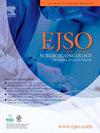一种预测微创食管切除术后食管鳞状细胞癌患者长期生存的新nomogram
IF 2.9
2区 医学
Q2 ONCOLOGY
引用次数: 0
摘要
食管癌是全球第七大常见癌症,而食管鳞状细胞癌(ESCC)是中国第四大癌症相关死亡原因。微创食管切除术(MIE)是ESCC的主要治疗方法。然而,仍然缺乏专门的工具来评估这些患者的术后结果。方法采用单因素和多因素COX回归分析,确定影响预后的因素。我们开发了一个nomogram来预测MIE术后1年、3年和5年的生存率。采用受试者工作特征(ROC)曲线、一致性指数(C-index)、校准曲线、决策曲线分析(DCA)曲线和风险分层评价所建立的nomogram预测效果。结果共709例患者入组。年龄、血管浸润、pT分期和pN分期是预后的独立预测因子,并用于建立nomogram模型。预测1年、3年和5年总生存(OS)的曲线下面积(AUC)值在训练组为0.814、0.761和0.794,在验证组为0.703、0.751和0.780。此外,校正图显示预测结果与实际观测结果吻合较好。DCA曲线证实nomogram与其他指标相比具有更高的临床价值。进一步,我们将整个患者人群分为低危组、中危组和高危组。三组间生存率差异有统计学意义(P < 0.001)结论:一种预测ESCC患者MIE术后生存结局的新nomogram。所提出的nomogram准确性超过了国际癌症控制联盟(UICC)/美国癌症联合委员会(AJCC)第8分期系统的准确性。本文章由计算机程序翻译,如有差异,请以英文原文为准。
A novel nomogram for predicting long-term survival in patients with esophageal squamous cell carcinoma after minimally invasive esophagectomy
Background
Esophageal cancer is the 7th most common cancer worldwide, while esophageal squamous cell carcinoma (ESCC) is the 4th leading cause of cancer-related deaths in China. Minimally invasive esophagectomy (MIE) is the employed as the primary treatment for ESCC. However, there is still a lack of specialized tools for evaluating postoperative outcomes in these patients.
Methods
Univariate and multivariate COX regression analyses were conducted to identify the prognostic factors. A nomogram was developed for predicting the survival probabilities at 1-, 3- and 5- year after MIE. The prediction performance of the developed nomogram was evaluated using the receiver operating characteristic (ROC) curve, concordance index (C-index), calibration curve, decision curve analysis (DCA) curve and risk stratification.
Results
A total of 709 patients were enrolled in the study. Age, vascular invasion, pT stage and pN stage were independent predictors of the prognosis and were used to develop a nomogram model. The areas under the curve (AUC) values predicting overall survival (OS) at 1, 3 and 5 years were 0.814, 0.761 and 0.794 in the training cohort and 0.703, 0.751 and 0.780 in the validation cohort. Furthermore, the calibration plot revealed good agreement between the predicted results and actual observations. The DCA curve confirmed that the nomogram achieved higher clinical value compared to other indicators. Further, we stratified the entire patient population into low-risk group, medium risk group and high-risk group. A significant difference in survival was observed between the three groups (P < 0.001)
Conclusions
A novel nomogram for predicting ESCC patient's survival outcomes after MIE. The accuracy of the proposed nomogram exceeded that of the Union for Union for International Cancer Control(UICC)/American Joint Committee on Cancer(AJCC) 8th staging systems.
求助全文
通过发布文献求助,成功后即可免费获取论文全文。
去求助
来源期刊

Ejso
医学-外科
CiteScore
6.40
自引率
2.60%
发文量
1148
审稿时长
41 days
期刊介绍:
JSO - European Journal of Surgical Oncology ("the Journal of Cancer Surgery") is the Official Journal of the European Society of Surgical Oncology and BASO ~ the Association for Cancer Surgery.
The EJSO aims to advance surgical oncology research and practice through the publication of original research articles, review articles, editorials, debates and correspondence.
 求助内容:
求助内容: 应助结果提醒方式:
应助结果提醒方式:


